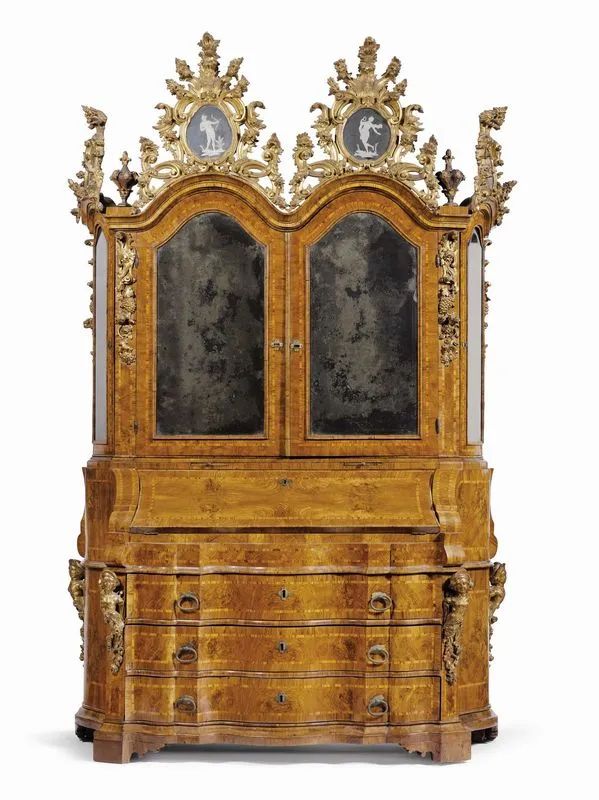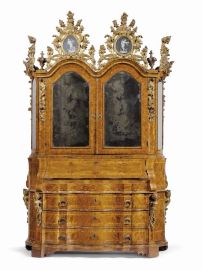BUREAU CABINET WITH FALL FRONT AND HIGH TOP
VENICE, MID-18TH CENTURY
Chestnut veneered and chestnut briar root and bois de rose frames and internal and secret drawers; the upper section with lateral panelled doors is internally decorated with mythological figures framed by elegant yellow-ochre rocailles on a faux background; rich copings and carved giltwood additions, 260x165x70 cm
Comparative literature
G. Morrazoni, Il Mobile Veneziano del ’700, Milano 1958, vol. II, tavv. CCCLXIX, CCCLXXII;
C. Santini, Mille Mobili Veneti. L’arredo domestico in Veneto dal sec. XV al sec. XIX, Modena 2002, pp. 73-76
This bureau cabinet with two front and two lateral copings, made of large carved giltwood frameworks to frame the typical carved glasses, can be admired on all sides together with its lightness and elongated shape. Under each coping a panelled door, each decorated with a mirror, opens to a surprising interior: together with the traditional numerous compartments for porcelain and precious objects, the panels and drawers of this piece of furniture are embellished by mythological deities, enriched by rocailles and by finely decorated yellow-ochre putti on a faux wood background; in the upper half-moon openings two winged putti hold two coats of arms, probably belonging to the families that commissioned this cabinet in occasion of their wedding. The paintings were conventionally attributed to the famous painter Marco Marcola of Verona (1740-1793), whose decorations ranged from signs, furniture, sedans and gondolas.
The lower section of this bureau cabinet, entirely veneered in chestnut and chestnut briar root, reveals a rich interior with small drawers and secret drawers, elegantly framed within bois de rose frameworks. This imposing and rare bureau cabinet is characterized by elegant giltwood decorations, pilasters on the inferior legs and vine branches on the upper legs. All these features, together with the movements of the lines on the furniture, where to an exuberant movement on the front corresponds an elegant and rounded one on the sides, represents the apogee of the Venetian craftsmanship in cabinet making, whose precious pieces were addressed to wealthy and elegant customers.
In French, the word trumeau originally defined the central pillar of a portal in the Gothic architecture but later, after the 18th century, it indicated the mirror hung in the corresponding space. This trumò, as pronounced in Italian, very soon became the pre-eminent and main piece of furniture in the elegant living rooms of the palaces of the Venetian aristocracy. Although they continued to keep the monumental proportions of the seventeenth-century, these pieces of furniture, more light and elegant in their shapes, became more functional: not only they represented the status of the owner, but they were also used as chest of drawers, desks and cabinets. The most expert craftsmanship and creativity was necessary to organize the interior spaces in order to create hidden drawers for the most important secrets.
In the half of the 18th century, the bureau cabinets, commissioned for the suburban villas, “casini” of the aristocracy of Veneto, became smaller to enter the more intimate and private rooms with lower ceilings of these dwellings, where the Venetian aristocracy spent the time in pleasant conversations accompanied by the music of a spinet piano and by the tinkling of porcelain cups. The decoration of this new kind of furniture was often made in soft lacquered colours or in arte povera in order to soften the already small proportions.
The traditional impressive chestnut veneered bureau cabinets, with their wavy lines and scrolled elements, similar to the one presented here, continued, however, to be exhibited in the large gilded salons of the richly decorated palaces, that the Venetian aristocracy opened for important events and ceremonies to celebrate both the splendour of the families and that Venice itself.
This rare and incredibly well-preserved piece of furniture can be compared to other bureau cabinets today in important collections, such as the one once in the Emanuele and Franco Subert Collection in Milan, auctioned by Sotheby’s in 2014 (see fig. 1), or the ones in the G.S. Collection and in the Tullio Silva Collection (see fig. 2-3), similar to ours in their curvy structure and in the richly carved decorations around the engraved mirrors.
Peculiar element of this bureau cabinet is the frontal double coping with carved mirror, depicting Mercury firing an arrow against Psyche to bring her to Olympus to her future groom, Love, and the side coping with mirrors, decorated with winged putti holding flowers. The presence of the two mythological figures of Mercury and Psyche and of the two coats of arms in the internal panelled doors confirms the hypothesis that this piece was commissioned in occasion of a prestigious wedding in order to celebrate the union of two important families.
































